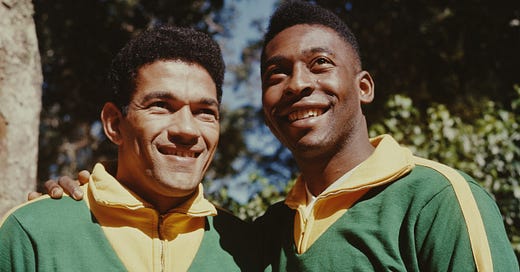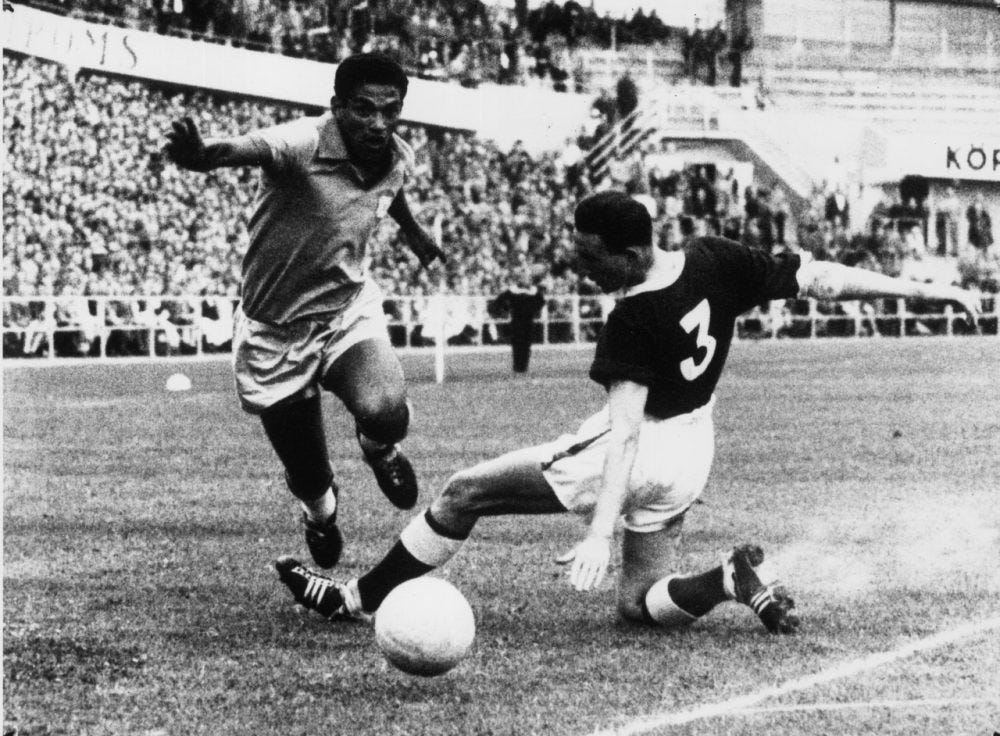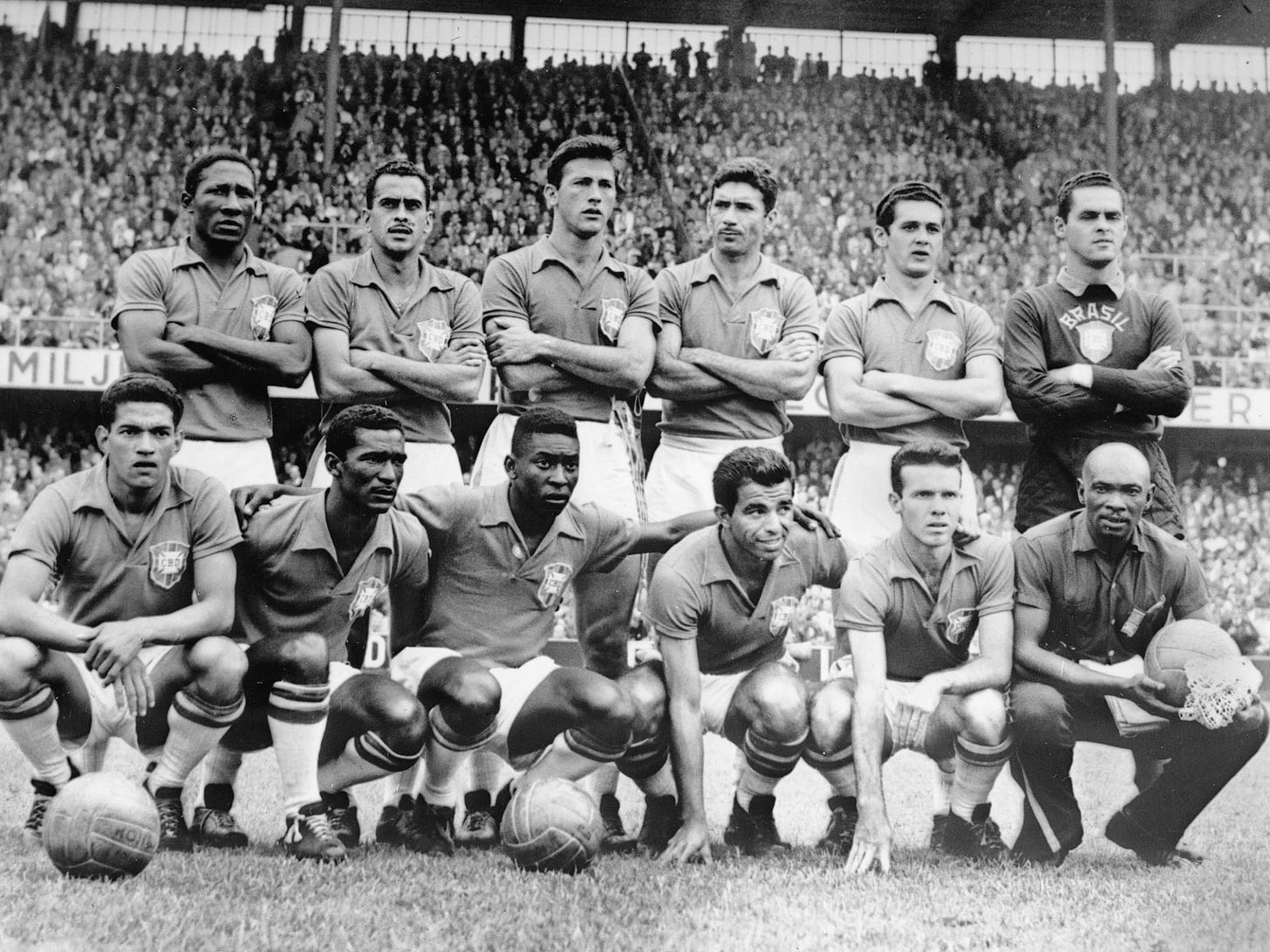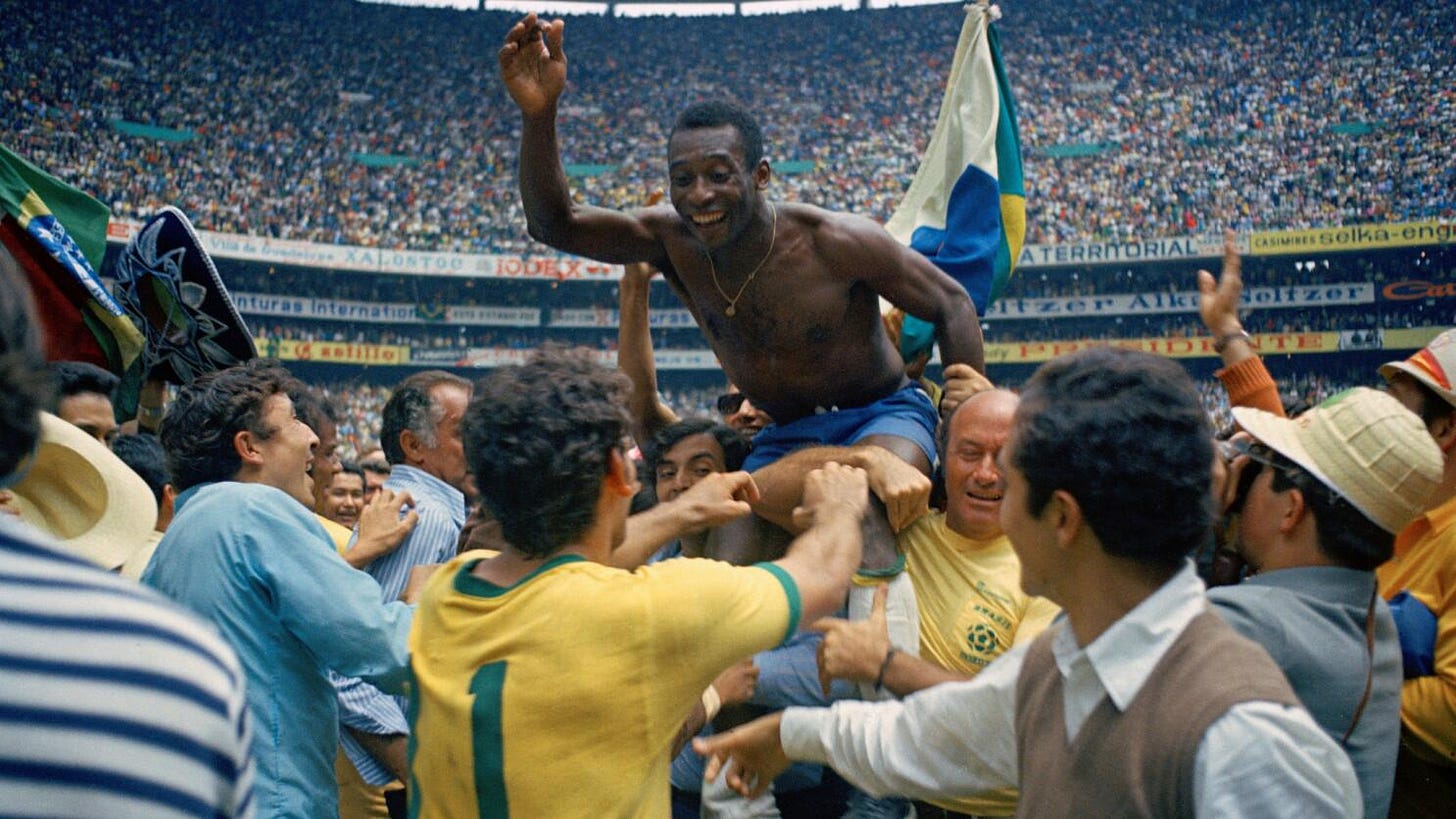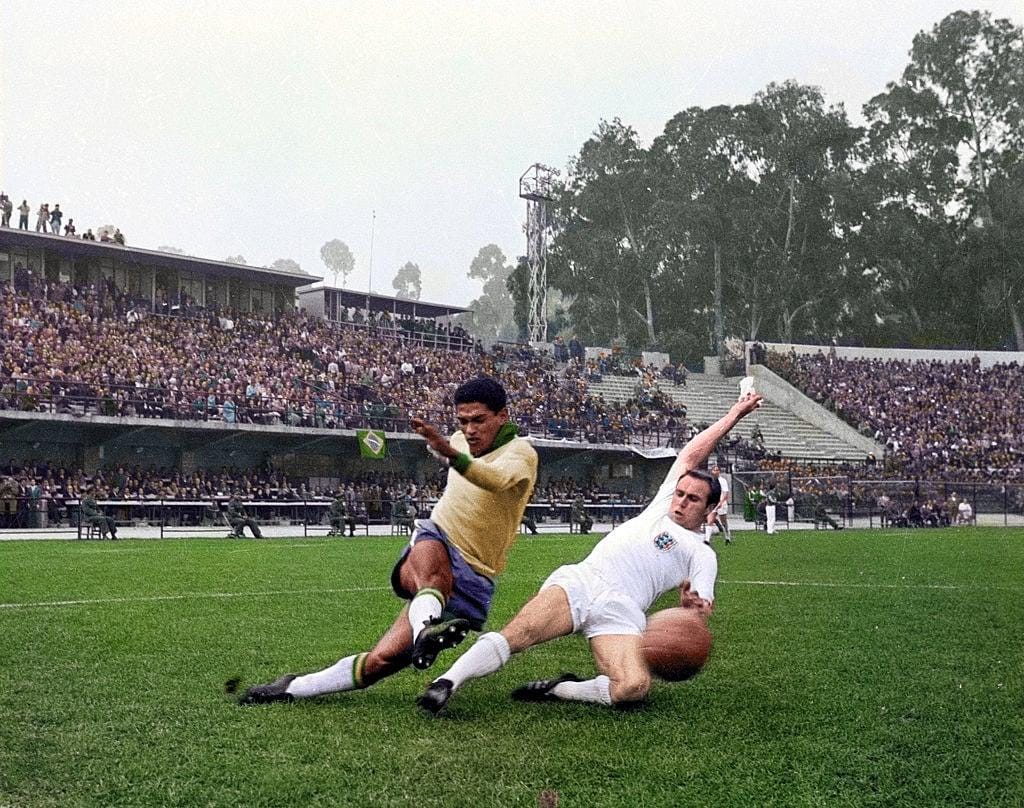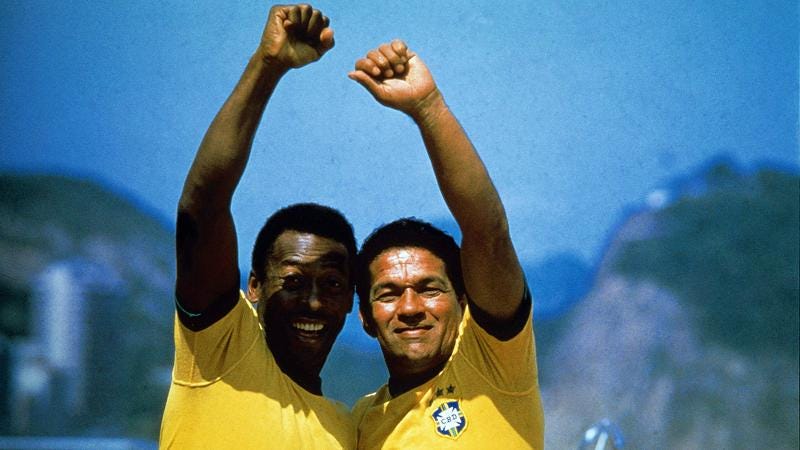If you missed part one of this retrospective on Brazilian icon Garrincha, you can get it here.
Now for part two - on Brazil & Pele.
While Brazilians put Pele on a pedestal, they do not love him the way they love Garrincha, It is more than the fact that tragic figures are naturally more appealing, since they are more human, although this probably helped. It is because Pele does not reflect rational desires, Pele, above everything else, symbolises winning, Garrincha symbolises playing for playing’s sake. Brazil is not a country of winners. It is a country of people who like to have fun.
Alex Bellos.
1958 WORLD CUP
In 1955 the CBD organised two friendlies against Chile, one was to be played by a Brazil team hailing from Rio, and another from Sao Paulo. Former Botafogo manager Zeze Moreira was given the reins of the Rio team, and Vicente Feola, Sao Paulo.
Moreira's first move was to cap Garrincha who, predictably, was unaffected. To play for the Selecao in Brazil is to achieve pretty much the highest honour in the land. Millions dream of it from a young age, not just because of the rewards – financial or otherwise - it may bring, but for the pride of representing a country seen by many as the game's spiritual home.
For Garrincha, not even that mattered. Whether he was called up or not, he was the same man. His complete lack of interest in the rewards football could bring him was phenomenal. Prior to the 1958 World Cup there is no record of his ever having said whether or not he thought he was worthy of a place in the team.
Ruy Castro's words are borne out by an incident related by the Flamengo full-back Jordan, who went to the bar at squad venue the Paysandu Hotel with his teammate. Garrincha ordered two waters, but smiled in his impish way at the barman, who duly poured two cachaça. Jordan was shocked, but needn’t have worried - come game day, Garrincha spent most of the match embarrassing his opponents.
In truth, Brazil were desperate for personalities impervious to pressure. Following on from the 1950 and 1954 World Cups, the view espoused by other nations was that, for all their talent, the Canarinho didn’t have the fortitude to win it.
In 1950 on home soil, despite the attacking trident of Zizinho, Ademir and Jair, they were vanquished by a resilient Uruguay in the final. Then again in 1954, in Switzerland, they lost an infamous game against Hungary that came to be known as the 'Battle of the Berne', in which an on-pitch contest to injure each other spilled over into the dressing room after Brazil had been beaten, 3-2.
Brazilians demanded more from their players, and from their management. Both responded. The team which pitched up in Sweden was the most organised Brazil team ever to have touched down for a tournament. Vicente Feola was the main man in charge and, as well as scouting for a suitable base months in advance, they also flew over armed with a doctor and – years ahead of their time – a psychologist.
Feola was organised, disciplined and, crucially, brought with him two players who would define Brazil at the next three World Cups: the ‘Little Wren’ and a boy who came from a poor black family at Tres Coracoes; a 17-year-old Santos forward who went by the name of Pele.
But both youngsters almost missed out.
Just days after Garrincha and Pele played their first ever game together – a 3-1 friendly win over Bulgaria at the Pacaembu in which Garrincha scored two goals – Pele took a kick on the knee from defender Ari Clemente, in an ill-advised match against club side Corinthians the CBD had organised to raise cash.
It almost cost them the World Cup. Pele, not fit, and in real pain, luckily still got a spot on the plane. He had asked to go home after failing a fitness test, but doctor Hilton Gosling guaranteed he’d be ok to play the tournament after 10 days of convalescence.
More stress was to follow in Europe when the squad payed a friendly against Fiorentina. The Little Wren had the crowd in ecstasy as twisted blood and tortured ankles littered the path of his flight. The score was 3-0. Goal number four had everyone up in arms, but for different reasons.
Garrincha, with his stop-start dribble, his lightening quick change of direction and dancing feet went past fullback Robotti, then Mangini and Cervati. He dummied goalkeeper Sarti and an open goal yawned before him. He dallied and, as he did so, Robotti faced up once more, Garrincha shimmied, left him tangled with the goalpost, before sticking the ball in the net.
“The goal was a stunner, and the terraces fell silent in awe” writes Castro. “His teammates, however, did not throw themselves on him to celebrate. They screamed at him. The Italians probably thought they were congratulating him, but had they understood Portuguese they would have heard the opposite. Almost the whole team was furious with him, Bellini for example: ‘This is the World Cup for fuck’s sake!’ Garrincha looked at him in disbelief. Why was he so angry? It wasn’t as if the World Cup had started yet; it was just a friendly with a club side. And they were 3-0 up with only 15 minutes to go.”
But the trauma lingered - Brazilian players were terrified he would do something similar in a crucial World Cup game. For them, his unpredictability was both a blessing and curse. But regardless of the uncertainty his actions precipitated amongst teammates, the truth was, most of the time he was unplayable.
Garrincha, though, wasn't to get on the pitch until the third fixture of their tournament. Management, perhaps with his on-pitch excesses in mind, went with Joel in the first match against Austria – a useful, and crucially, tactically responsible, right winger.
They won 3-0 rather fortuitously and, ahead of their second game against England - a 0-0 draw - scout reports from their spy Ernesto Santos cautioned Feola about left-back Tommy Banks, who was competitive to the point of brutality.
The Little Wren, caged at the Tourist Hotel in Hindas, out in the countryside between Gothenburg and Boras, was no longer singing. He was so depressed at being denied the chance to to what he loved, to dribble, that he asked Hilton Gosling if he thought he should go home. Be patient came the swift response.
He started the next game against the USSR. Not because of a dressing room revolt as spurious accounts later claimed, but because propaganda about the Russian’s ‘scientific’ fitness scared Feola and his advisors into trying to score an early goal, and the best way to do that was to be gung-ho from the kick-off.
Garrincha and Pele – his knee deemed good enough – both started. The message from Feola ahead of the game was: get the ball to the boy from Pau Grande.
It worked.
The first three minutes of the game saw the Russians scrabbling around madly as Garrincha led them a merry dance; hitting the post and leaving players on their backsides. The crowd lapped it up. Pele, a lithe, agile forward with a tremendous touch and the temperament of a yogi hit the opposite post. Brazil had found their groove.
At one point, when Garrincha’s trickery forced an opponent to the ground, he stopped, extended his hand and helped him up before promptly passing him a second time. They ended up winning 2-0 with a double from Vava but the crowd and, more importantly, the Russian team - especially after one glorious moment where Garrincha held off five of their encircling players - knew who the hero was:
Their proud scientific football had never before been so demoralised, and by the most improbable source: a poor Brazilian peasant – dark-skinned, small as a bird, cock-eyed and with ridiculously crooked legs. Garrincha was a perfect example of anti-science; he was anti-sputnik, anti-electronic brain, anti-any brain, Kessarev, Krijveski, Voinov, Tsarev and especially Kuznetzov were all taken to the cleaners by the little man at some point during the game, either one at a time or in pairs or threes, or sometimes even one after another… Garrincha had arrived, and not just for those watching live but for those listening in at home. From that day on there were no more Botafogo fans, Fluminense fans, Flamengo fans, Corinthians fans or Gremio fans. Everyone was now a Garrincha fan even when he played against their own team.
In fact, it wasn’t just Garrincha who had arrived, but his partnership with Pele too. Throughout his international career, Garrincha never lost a game when playing with the Santos man. They blitzed their way to the final against Sweden where, inspired by Garrincha, who set up two goals for Vava with some scintillating chicanery out on the wing, and a goal form Pele that many perceive to have been his best – he flicked a ball over a defender's head before volleying high into the net – they won 5-2 and brought the World Cup home to scenes of jubilation.
1962 WORLD CUP
In 1958 Garrincha found fame, but he found it with the rest of the Brazil squad. It was after their next World Cup success in Chile in ’62 that the cult of personality around the Little Wren really hit escape velocity.
But in the lead up to the tournament, Garrincha’s star had been set back in its socket by the brightness of another - the man who’d scored a wonder goal against their hosts in '58.
In the four years since winning the World Cup, Pele had become a phenomenon. His Santos team had won the Paulista championship in 1958, 1960 and 1961, the Rio-SP tournament in 1959 and the Brazilian Cup in 1961. Pele was the top goalscorer in almost every competition he played in, and in the 1958 Paulista championship he scored an astonishing 58 goals, a record that still stands to this day.
In total Pele scored a staggering 111 goals in 75 appearances in 1961. But it was not a World Cup the Santos man would remember fondly: he limped off in their game against Czechoslovakia with a groin injury and didn’t play again. It was left to another to win them the tournament, and he did so, in a manner matched in football's history only once - by Diego Maradona in 1986.
The 1962 World Cup was the theatre of Garrincha’s grandest performances - he married entertainment with efficacy, first flickering into life in their final group game against Spain, having previously being subdued against Mexico and the Czechs. His mercurial wing play set up Amarildo, playing instead of Pele, for one of his two match-winning goals.
Next, against England in the quarter-finals, Garrincha scored a header and an outrageous 'banana' shot to almost single-handedly send the Selecao into the next round with a 3-1 win.
The English press described him as 'Stanley Matthews, Tom Finney, and a snake charmer all rolled into one'. The feat was all the more noteworthy because the rest of the squad were suffering from anxiety brought on by the sheer weight of expectancy and the loss of Pele.
Not Garrincha - he played as if skirting the embankment in Pau Grande and England's legendary keeper Gordon Banks still, to this day, calls him the best player he has ever seen.
He excelled against Chile in the semi-final too, roiling the crowd with the audacity of his play and two superb goals – one a left-foot drive and the other a header – as well as laying on another for Vava in a 4-2 win, prompting the Chilean newspaper El Mercurio to ask the next day: “What planet is Garrincha from?”
But just as Garrincha-fever was reaching its crescendo, disaster struck – he was uncharacteristically sent off for kneeing Chile’s centre-half Eliado Roja, a player he had come up against before when Botafogo played Colo Colo. Roja, fearful of being tormented all game, had kicked him at every opportunity, and Garrincha’s playful retaliation was seen.
Fortunately, the FIFA disciplinary committee which met to review the ban may have been swayed by its more senior members, who were grateful to Brazil for hosting the World Cup in 1950, which had saved them from near bankruptcy. Brazil’s Prime Minister Tancredo Neves also got involved, and his influence was decisive - Garrincha was cleared to play.
There was pressure on Brazil’s management to field a patently unfit Pele in the final, but they held firm, and despite going 1-0 down to Czechoslavakia, won 3-1 with Amarildo scoring expertly from an acute angle before laying on a superb second for Zito.
Vava scored the third, and Garrincha indulged the watching world by keeping hold of the ball as the clocked ticked down. Brazil were double World Cup champions. Garrincha finished joint top-scorer and was crowned player of the tournament. Now his star was bright; brighter even, than Pele’s.
Years later, when they met up for the last time at an encounter organised by the football magazine Placar, Garrincha, by then in the throes of alcoholism and nigh on destitute, kept cheekily referring to Pele as the ‘King’ in response to his nickname ‘O Rei’ but there was no attendant bitterness.
The two men chatted about football and their past, before hugging warmly and going their separate ways. Pele, as well as the other squad members, always acknowledged the huge role Garrincha played in their success, saying:
Garrincha was an phenomenal player, one of the best there has ever been. He could do things with the ball that no other player could do and without Garrincha, I would have never been a three-time world champion.
In 1963 a biographical film was released with the title: Garrincha – Alegria de Povo (Joy of the People) and their respective nicknames tell us so much about the way they are cherished in Brazil; Pele revered, Garrincha loved in the manner befitting his personality.
Pele and Garrincha are two players who symbolise Brazil yet paradoxically, were worlds apart. Both were united by sublime ability, but whereas Pele’s was underpinned by professionalism and responsibility, Garrincha was the antithesis – the carefree, irresponsible entertainer.
Garrincha was a breed of footballer on the verge of extinction by the time Pele showed up; at the dawn of professional sports and marketable sportsmen and women.
Brand Pelé was helped in the sense that his prominent rise coincided with the advent of television, while Garrincha was at his bewitching best at a time when, starved of exposure (and, by extension, money) football was far more compartmentalised. So the world remembers The King much more than the Little Wren.
Alex Bellos, in Futebol: The Brazilian Way Of Life summed up the differences between the two icons:
Whereas Garrincha indulged in most vices available to him, Pele behaved always as a model player. He led a self-imposed ascetic life, concentrating on training and self-improvement. Pele learned from others, and improved over time. Garrincha was unteachable. Pele had an athlete’s perfect body. Garrincha looked like he should not be able to walk straight. When Garrincha was still stuffing his wages into a fruit bowl, Pele had registered his name as a trademark, employed a manager, invested money in business projects and advertised products…Garrincha demonstrated, quite spectacularly, that there is no safety net in Brazilian society – while Pele, unlike almost all his peers, found a career beyond football, Garrincha only ever thought of the short term, Pele was – and is – always making plans, Garrincha argued with the establishment. Pele became the establishment.
And the Little Wren’s lack of structure; his vice, irreverence & fame were to lead him to far darker places.
This article originally appeared in Issue Zero of The Green, then was later extended & updated for Issue Seven.
Primary sources are Ruy Castro’s Garrincha: The Triumph and Tragedy of Brazil’s Forgotten Football Hero & Alex Bellos’ Futebol: The Brazilian Way Of Life.
Coming soon - Garrincha ‘Little Wren’ (Part 3 - The Dark Side of Irreverence, Where Myth & Reality Mingle).


